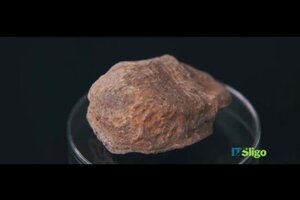When did humans arrive in Ireland? Fossilized bear knee resets the clock.
A bear bone that has been in a box at Ireland's national museum for more than a century shows that humans were on the island 2,500 years earlier than previously thought.

A remarkable archaeological discovery in a Co. Clare cave has pushed back the date of human existence in Ireland by 2,500 years. This discovery re-writes Irish archaeology and adds an entirely new chapter to human colonisation of the island – moving Ireland’s story into a new era. The discovery was made by Dr Marion Dowd, an archaeologist at IT Sligo, and Dr Ruth Carden, a Research Associate with the National Museum of Ireland.
Archaeologists in Ireland have determined that humans occupied the island 2,500 years earlier than previously thought.
The proof was in a butchered knee bone, or patella, that once belonged to a bear. It seems to have been sliced up by an amateur struggling to cut through to the animal’s tough knee joint with a flint blade.
According to radiocarbon dating of the bone by two independent institutions, it came from 12,500 years ago, which means humans were on the island earlier than expected. This was during the Palaeolithic era when humans were using stone tools, at the end of the Ice Age. Until the bear bone was dated, the earliest evidence of people living in the area dated from the Mesolithic era, 10,000 years ago.
“From a zoological point of view, this is very exciting, since up to now we have not factored in a possible ‘human-dimension’ when we are studying patterns of colonisation and local extinctions of species to Ireland,” Ruth F. Carden, a wildlife biologist at the National Museum of Ireland, said in an announcement of a paper she co-wrote on the subject set to be released in Quaternary Science Reviews.
“This paper should generate a lot of discussion within the zoological research world and it’s time to start thinking outside the box ... or even dismantling it entirely!” she said.
The bone was actually discovered more than a century ago by scientists, but has been hidden away in a cardboard box at the museum since.
It was was one of thousands of bones originally discovered in 1903 in the Alice and Gwendoline Cave, located in County Clare in western Ireland. The early team published a report on its findings, noting that the bear bone had knife marks.
It wasn’t until 2011, when Dr. Carden was reviewing the museum’s animal bone collections from early cave excavations, that she came across the peculiar bear bone. She teamed up with a cave archaeology specialist from the Institute of Technology Sligo in Ireland, Marion Dowd, to secure funding to radiocarbon date the bone first by Queen’s University Belfast, and then to verify its surprising findings, by the University of Oxford.
“When a Palaeolithic date was returned, it came as quite a shock,” said Dr. Dowd in an announcement of the results. “Here we had evidence of someone butchering a brown bear carcass and cutting through the knee probably to extract the tendons. Yes, we expected a prehistoric date, but the Palaeolithic result took us completely by surprise,” she said.
Three bone specialists in the Britain and in Hungary – independently and without knowledge of the radiocarbon dating results – confirmed that the slice marks were made on fresh bone, which means they were made at the same time, and that humans were in Ireland during the time, say the two scientists.
This finding comes two years after a cache of flint tools were discovered on the island of Islay in Scotland, also pushing back the earliest known time of human existence there from the Mesolithic into the Palaeolithic era.

